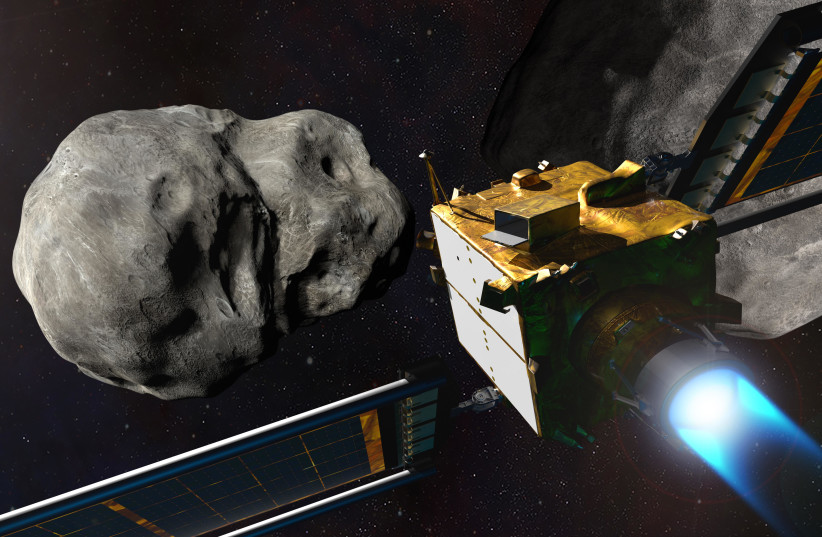Asteroid the size of 6 Darth Vaders to pass Earth on Star Wars Day – NASA
An asteroid the size of six Darth Vaders is set to pass the Earth on Thursday, May 4, also known as Star Wars Day, at a very close distance, according to NASA’s asteroid tracker.
The asteroid in question has been designated 2023 HF7, having been discovered this year, according to the Center for Near-Earth Object Studies (CNEOS) at NASA’s Jet Propulsion Laboratory (JPL).
It is also just the first in a trilogy of asteroids set to pass by the Earth on Thursday, but it will also be passing by at a much closer distance than the others.
The asteroid’s flyby also coincides with Star Wars Day, celebrated annually on May 4, or May the Fourth, to recall the iconic phrase “May the Force be with you.”
That’s no moon: How big is the asteroid coming toward Earth?
Asteroid 2023 HF7 is estimated by NASA to be around 12 meters in diameter at minimum.
 Darth Vader (Illustrative) (credit: PIXABAY)
Darth Vader (Illustrative) (credit: PIXABAY)To put that size into perspective, consider a far more timely and iconic metric: That of Darth Vader.
While his height has varied throughout the Star Wars franchise, such as when he was still Anakin Skywalker, the official Star Wars website lists his height as Vader at just over two meters.
In other words, this asteroid’s diameter is around the same as six Darth Vaders, standing on top of each other, with all the dark side power that would entail.
Always a bigger fish- or asteroid: What other asteroids are set to pass the Earth?
As previously stated, there is a trilogy of asteroids set to pass the Earth on Star Wars Day, and asteroid 2023 HF7 is merely the first installment.
Here are the others, along with their own Star Wars-themed size comparisons.
Asteroid 2023 HH7 is roughly 47 meters wide, or roughly equivalent to three and a half X-wing fighters, the iconic spaceship used by the Rebels to destroy the Death Star
Asteroid 2023 HZ4 is roughly 97 meters wide, which is just a bit smaller than the gigantic and terrifying Sarlacc that lurked beneath the sands of Tattooine
Never tell me the odds: Is an asteroid going to hit the Earth in 2023?
They say the ability to destroy a planet is insignificant compared to the power of the Force, but an asteroid impact would also come with a lot of force – explosive force, that is.
That is why there is plenty of reason to worry about these asteroids. But no worries, because while Star Wars may be a hit at the box office, these asteroids won’t hit Earth.
Both asteroids 2023 HF7 and 2023 HH7 are both coming closer than most asteroids, however, the former comes just over 637,000 kilometers away from Earth and the latter comes a little over 834,000 kilometers away from Earth.
That’s much closer than normal, but not closer than the Moon, which orbits the Earth at an average distance of roughly 384,000 kilometers.
In other words, no matter how scary it may seem, these asteroids will miss us by such a wide margin that one might think they were fired by imperial stormtroopers.
But asteroids and meteors have struck the Earth fairly recently, such as one that struck Israel back in April.
Several months earlier, a meteor the size of a Pembroke Welsh corgi – or just around half the size of the astromech droid R2-D2 – crashed into Texas.
Even earlier, several larger objects designated asteroids hit the Earth, such as 2022 EB5, which was half the size of a giraffe or around the size of the Tattooine-based crime lord Jabba the Hutt. Another one was asteroid 2023 CX1, which was the size of two Super Bowl trophies or about the size of an Ewok, the fuzzy bear-like natives of the Forest Moon of Endor.
None of these actually caused any damage to the Earth, because they are so small they end up burning in the atmosphere. Hardly just “another happy landing.”
 This illustration depicts NASA’s Double Asteroid Redirection Test (DART) spacecraft prior to impact at the Didymos binary asteroid system. DART’s target asteroid is the moonlet Dimorphos, which orbits the larger asteroid Didymos; the pair are not a threat to Earth. (credit: NASA/Johns Hopkins APL/Steve Gribben)
This illustration depicts NASA’s Double Asteroid Redirection Test (DART) spacecraft prior to impact at the Didymos binary asteroid system. DART’s target asteroid is the moonlet Dimorphos, which orbits the larger asteroid Didymos; the pair are not a threat to Earth. (credit: NASA/Johns Hopkins APL/Steve Gribben)Can we stop an asteroid from hitting Earth? Yes: This is the way
The archives aren’t incomplete for this one.
While an asteroid impact will by no means ever destroy the planet, the fact is that it could cause serious damage. Luckily, scientists are hard at work finding ways to defend the Earth from asteroids.
The most promising result of this research is NASA’s Double Asteroid Redirection Test (DART) Mission, which managed to help change the orbit of the faraway asteroid Dimorphous by crashing into it.
Scientists now know for sure that with enough time and planning, we know that this is the way we can safeguard the Earth from an asteroid impact.





Comments are closed.